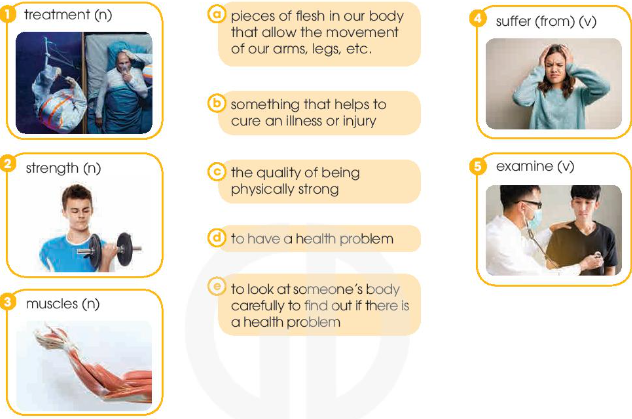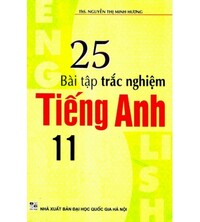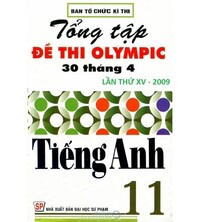Tiếng Anh 11 Unit 1 Language
Pronunciation 1. Listen and repeat. Pay attention to the strong and weak forms of the auxiliary verbs. Then practise saying them. 2. Work in pairs. Read these sentences out loud. Pay attention to the strong and weak forms of the auxiliary verbs. Then listen and check. Vocabulary 1. Match each word (1-5) with its meanings (a-e). 2. Complete the following sentences using the correct forms of the words in 1. Grammar 1. Put the verbs in brackets in either the past simple or the present perfect.
1
Strong and weak forms of auxiliary verbs
(Dạng mạnh và dạng yếu của trợ động từ)
1. Listen and repeat. Pay attention to the strong and weak forms of the auxiliary verbs. Then practise saying them.
(Lắng nghe và lặp lại. Chú ý đến dạng mạnh và dạng yếu của trợ động từ. Sau đó thực hành nói chúng.)
|
Weak forms (Hình thức yếu) |
Strong forms (Hình thức mạnh) |
|
Do you ...? /dǝ/ |
I do. /du:/ |
|
Does she...? /dǝz/ |
She does. /dʌz/ |
|
Can I ...? /kǝn/ |
You can. /kæn/ |
|
Weak forms (Hình thức yếu) |
Strong forms (Hình thức mạnh) |
|
Could we...? /kǝd/ |
We could. /kʊd/ |
|
Were they...? /wǝ/ |
They were. /wɜːr/ |
|
Has he ...? /həz/ |
He has. /hæz/ |
Mark: Have you started working out again?
/hǝv/
Nam: Yes, I have.
/hæv/
Mark: Was it your grandfather who taught you?
/wəz/
Nam: Yes, it was.
/wɒz/
Phương pháp giải:
Mark: Have you started working out again?
(Bạn lại bắt đầu làm việc bên ngoài à?)
Nam: Yes, I have.
(Vâng, đúng vậy.)
Mark: Was it your grandfather who taught you?
(Là ông đã dạy cho bạn à?)
Nam: Yes, it was.
(Vâng, đúng vậy.)
2
2. Work in pairs. Read these sentences out loud. Pay attention to the strong and weak forms of the auxiliary verbs. Then listen and check.
(Làm việc theo cặp. Đọc to những câu này. Chú ý đến dạng mạnh và dạng yếu của trợ động từ. Sau đó nghe và kiểm tra.)
1. Does she exercise? - Yes, she does.
(Cô ấy tập thể dục à? - Đúng vậy.)
2. Were you eating healthily? - Yes, I was.
(Bạn ăn uống lành mạnh nhỉ? - Đúng vậy.)
3. Do you eat vegetables? - Yes, I do.
(Bạn có ăn rau củ không? - Có.)
4. Can he get up early? - Yes, he can.
(Anh ấy có thể thức dậy sớm không? - Vâng, anh ấy có thể.)
Lời giải chi tiết:
1. Does she exercise? - Yes, she does.
/dǝz/ /dʌz/
2. Were you eating healthily? - Yes, I was.
/wǝ/ /wɒz/
3. Do you eat vegetables? - Yes, I do.
/dǝ/ /du/
4. Can he get up early? – Yes, he can.
/kǝn/ /kæn/
1
Health and fitness
(Sức khỏe và sự cân đối)
1. Match each word (1-5) with its meanings (a-e).
(Nối mỗi từ (1-5) với nghĩa của nó (a-e).)

Phương pháp giải:
treatment (n): sự điều trị, phương pháp trị liệu
strength (n): sức mạnh
muscles (n): cơ bắp
suffer (from) (v): chịu đựng
examine (v): kiểm tra
Lời giải chi tiết:
|
1 - b |
2 - c |
3 - a |
4 - d |
5 - e |
1 - b: treatment (n) = something that helps to cure an illness or injury
(sự điều trị, phương pháp trị liệu = cái gì đó mà giúp bạn để điều trị bệnh hoặc vết thương)
2 - c: strength (n) = the quality of being physically strong
(sức mạnh (n) = chất lượng của thể chất mạnh mẽ)
3 - a: muscles (n) = pieces of flesh in our body that allow the movement of our arms, legs, etc.
(cơ bắp (n) = những miếng thịt trong cơ thể chúng ta cho phép cử động của cánh tay, chân, v.v.)
4 - d: suffer (from) (v) = to have a health problem
(chịu đựng (v) = có một vấn đề sức khỏe.)
5 - e: examine (v) = to look at someone's body carefully to find out if there is a health problem
(khám bệnh (v) = nhìn cơ thể của ai đó một cách cẩn thận để tìm hiểu xem có vấn đề gì về sức khỏe không.)
2
2. Complete the following sentences using the correct forms of the words in 1.
(Hoàn thành các câu sau sử dụng dạng đúng của dạng từ trong bài 1.)
1.The doctor _______ her carefully, but could not find anything wrong.
2. He is receiving ________ for his health problem.
3. Regular exercise can help you improve your muscle _________.
4. To build your __________ you can try lifting weights.
5. Nam can't sleep well. He is ______________ stress.
Lời giải chi tiết:
|
1. examined |
2. treatment |
3. strength |
4. muscles |
5. suffering (from) |
1. The doctor examined her carefully, but could not find anything wrong.
(Bác sĩ kiểm tra cô ấy một cách cẩn thận, nhưng đã không thể tìm ra bất kỳ bệnh nào.)
2. He is receiving treatment for his health problem.
(Anh ấy đang nhận sự điều trị cho vấn đề sức khỏe của anh ấy.)
3. Regular exercise can help you improve your muscle strength.
(Tập thể dục thường xuyên có thể giúp bạn cải thiện sức mạnh của cơ.)
4. To build your muscles you can try lifting weights.
(Để tạo cơ bắp của bạn, bạn có thể thử nâng vật nặng.)
5. Nam can't sleep well. He is suffering (from) stress.
(Nam không thể ngủ tốt. Anh đang trải qua căng thẳng.)
1
Past simple vs. Present perfect
(Thì quá khứ đơn và Hiện tại hoàn thành)
1. Put the verbs in brackets in either the past simple or the present perfect.
1. He (see)______ the doctor yesterday.
2. She (suffer)________ from a serious headache, but after treatment, she felt better.
3. Our living conditions (improve)______ over the last few decades. Now people live much better.
4. The doctor (just, examine) __________ her. Fortunately, the treatment is working.
Phương pháp giải:
Thì quá khứ đơn với động từ thường:
(+) S + Ved/2
(-) S + did + not (= didn’t) + V
(?) Did + S + V
Thì hiện tại hoàn thành
(+) S + has/have +Ved/V3
(-) S + have/ has + not (haven’t/hasn’t) + Ved/3
(?) Have/Has + S + Ved/3?
Lời giải chi tiết:
|
1. saw |
2. sufered |
3. has improved |
4. has just examined |
1. He saw the doctor yesterday.
(Cô ấy đã gặp bác sĩ vào hôm qua.)
Giải thích: Dấu hiệu nhận biết quá khứ đơn "yesterday" => see (v) - saw (V2)
2. She sufered from a serious headache, but after treatment, she felt better.
(Cô ấy đã chịu đựng một cơn đau đầu dữ dội, nhưng sau khi điều trị, cô ấy đã cảm thấy tốt hơn.)
Giải thích: Động từ ở mệnh đề phía sau chia thì quá khứ đơn "felt" nên chỗ trống cũng chia thì quá khứ đơn => suffer (v) - suffered (Ved)
3. Our living conditions have improved over the last few decades. Now people live much better.
(Điều kiện sống đã được cải thiện trong vài thập kỷ qua. Bây giờ mọi người sống tốt hơn nhiều.)
Giải thích: Dấu hiệu nhận biết thì hiện tại hoàn thành "over the last few decades".
4. The doctor has just examined her. Fortunately, the treatment is working.
(Bác sĩ vừa kiểm tra cho cô ấy. Thật may mắn, sự điều trị đang hiệu quả.)
Giải thích: Dấu hiệu nhận biết hiện tại hoàn thành "just" => S(số ít) + has just + Ved/V3.
2
2. Work in pairs. Talk about what you do to keep fit and healthy. Use the past simple and the present perfect.
(Làm việc theo nhóm. Nói về việc bạn làm để giữ dáng và khỏe mạnh. Sử dụng thì quá khứ và hiện tại hoàn thành.)
Example: I have exercised regularly for a year. I went swimming last weekend.
(Ví dụ: Tôi tập thể dục thường xuyên khoảng 1 năm. Tôi đi bơi cuối tuần trước.)
Lời giải chi tiết:
A: I have exercised regularly for a year. I went swimming last weekend.
(Tôi đã tập thể dục thường xuyên khoảng một năm. Tôi đã đi bơi vào cuối tuần trước.)
B: That’s great. I started doing yoga last week. My mom has done yoga for five years. And, my sister’s healty habit is cooking a healthy meal, she has done for 3 years.
(Điều đó thật tuyệt. Tôi bắt đầu tập yoga vào tuần trước. Mẹ tôi đã tập yoga được năm năm. Và, thói quen tốt cho sức khỏe của chị gái tôi là nấu một bữa ăn lành mạnh, chị ấy đã thực hiện được 3 năm.)
A: Wow! I think that healthy habits is good for us, so let’s keep doing that.
(Chà! Tôi nghĩ rằng những thói quen lành mạnh là tốt cho chúng ta, vì vậy hãy tiếp tục làm điều đó.)
B: Yes, I totally agree with you.
(Vâng, tôi hoàn toàn đồng ý với bạn.)
Search google: "từ khóa + timdapan.com" Ví dụ: "Tiếng Anh 11 Unit 1 Language timdapan.com"







